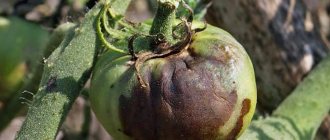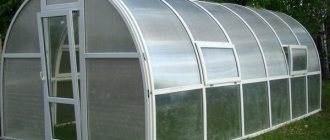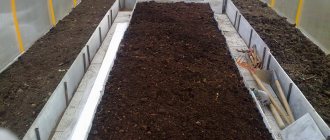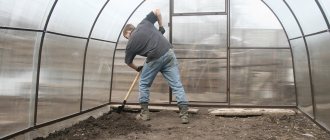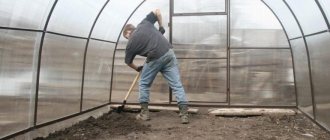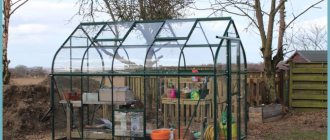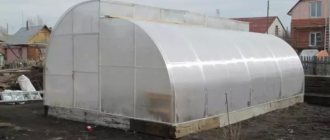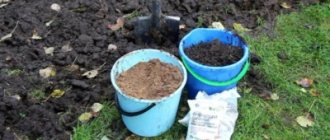Why is it dangerous for whiteflies to appear in a greenhouse?
The whitefly is a small insect of the order Aleurodidae. Externally, it looks like a moth or midge 2-3 mm in size. The body is greenish-white, covered with a whitish coating. It has two pairs of white opaque wings and a small proboscis. With its help, the pest feeds on the sap of young plants. It can often be seen in beds with cabbage or cucumbers. The whitefly multiplies extremely actively in greenhouses where tomatoes are grown.
It is especially dangerous in the summer. On hot days, no more than 3 weeks pass from laying eggs to the appearance of sexually mature individuals. And if the insect lays eggs mainly in the soil, then the larvae with rounded translucent bodies of a greenish or yellowish tint form colonies on the inside of plant leaves. They also feed on plant sap.
For vegetable crops, the rapid proliferation of whiteflies threatens death. The leaf blades turn yellow and curl, the plant slows down in growth, and the formation of new inflorescences and ovaries is reduced.
Attention! During their life, whitefly larvae secrete a sticky, sugary substance. It becomes a place for the development of sooty fungus. First, a white coating appears on the leaves, turning into black or brown spots. As the disease progresses, the fruits are also affected. Thus, gray-black small spots appear on tomatoes. Vegetables do not have time to ripen and lose their commercial qualities.
The peculiarity of the whitefly is that it settles in the greenhouse at the beginning of the season. The first to suffer is the planted seedlings. Therefore, experienced vegetable growers recommend inspecting the plantings 10-15 days after planting the plants in the greenhouse. It is difficult not to notice the insect. White moths flying up from the leaves and their larvae on the back of the leaf blades should be on your guard.
Conclusion
Getting rid of whiteflies in a greenhouse in the fall means protecting the next season's crop. Moreover, greenhouses in any case need to be prepared for winter. Otherwise, during the growing season you will have to resort to using various means of controlling pests and diseases, which negatively affects the quality of the crop.
Sources
- https://dachnoedelo.ru/tchem-obrabotaty-teplitsu-osenyyu-ot-belokrlki.html
- https://fermilon.ru/sad-i-ogorod/vrediteli/obrabotka-teplitsy-osenyu-ot-belokrylki.html
- https://parnik-teplitsa.ru/belokrylka-v-teplice-213
- https://zen.yandex.ru/media/lifehackneys/chtoby-izbavitsia-ot-belokrylki-ia-vsegda-obrabatyvaiu-teplicu-oseniu-rasskazyvaiu-kak-eto-nado-delat-5f3827448d67a852363de2e5
- https://m-strana.ru/articles/kak-borotsya-s-belokrylkoy-v-teplitse-5-deystvennykh-sposobov/
- https://dachnik0ff.ru/tepliczyi/belokryilka-v-teplicze-kak-izbavitsya.html
- https://belt-wrestling.su/muhi-i-moshki/kak-izbavitsya-ot-belokrylki-v-teplice.html
- https://wiki-dacha.ru/kak-borotsya-s-belokrylkoy-v-teplice
- https://AgroGnom.ru/building/hotbeds/obrabotka-teplitsy-ot-belokrylki-vesnoj.html
[collapse]
What to do in a greenhouse in the fall if a whitefly appears in it
You shouldn’t wait until autumn to start fighting the pest. There is a high probability of being left without a harvest. In the fall, greenhouses are finally treated for whiteflies and more to prevent re-infestation next season.
Timing for treatment of greenhouses against whiteflies in autumn
Treatment of the greenhouse in the fall, if there is a whitefly in it, is carried out as soon as possible after the final harvest. The fact is that most drugs do not affect egg laying. This means that 2 or even 3 treatments will be needed, which must be completed before the onset of frost. This is the only way to destroy the entire population.
Preparing the greenhouse for processing
Before you start treating a polycarbonate greenhouse in the fall against whiteflies, it needs to be prepared for this process.
After harvest:
- remove all plant remains, fallen fruits, branches, leaves;
- remove auxiliary equipment, ropes for tying or supports;
- remove rhizomes;
- carefully weed out weeds;
- wash all surfaces of greenhouses both inside and outside with a solution of laundry soap at the rate of: 1 grated bar per 10 liters of water;
- metal structures are treated with a solution of copper sulfate or kerosene;
- wooden parts or supports are whitewashed.
After preparatory activities, the soil is dug up to a depth of 30-40 cm.
Herbal infusions and herbal decoctions
Not every method gives the desired result, however, when a person does not want to use chemicals, he should use proven herbal infusions:
- Dandelion root tincture. It will take approximately 100 g. Afterwards, the raw materials are poured with boiling water. Next, leave for 1 day and spray the tomatoes.
- Sugar solution. Dissolve 2 tbsp. sugar in 1 tbsp. with water and treat plants where there are manifestations of insect damage. When it doesn’t help, spraying is repeated after a week. After a week, the leaves are sprayed with water to remove sugar coating.
- Garlic tincture. Crush 15 g of garlic cloves and add 100 g of water. Cover with a lid and infuse for 5 days. The product turns out to be extremely saturated, therefore, to treat the plants, you need to mix 5 g of solution in 1 liter of water.
- Tincture of tobacco dust. Prepare as follows: 1 package per 1 liter of water. This mixture is infused for 7 days. You need to spray every 5 days.
- Lemon peel tincture. 100 g of the product is poured with water, left for a day, then 60 g of a solution with soap is added, and the damaged parts of the plant are treated.
- Ammonia. For 10 liters of water you will need 35 ml of 10% ammonia solution. Plants are sprayed with it. A similar method is used before tomatoes bloom.
- Yarrow tincture. The grass is finely chopped, scalded with boiling water, 1 liter of water is poured in and infused for a day. Treat the affected plants: when the foliage is large, wipe with cotton wool soaked in the tincture. For plants with small leaves, spraying is more effective.
When treating plants for whiteflies, it is extremely important to focus on the lower areas of the foliage.
How and how to treat a greenhouse after whitefly in the fall
When treating soil and greenhouses in the fall against whiteflies, it is worth remembering that, as a rule, adults and larvae die before they pupate. In addition, the insect has such a feature as addiction to many drugs. In the fight against the pest, comprehensive measures must be used.
Treating a greenhouse against whiteflies in the fall with chemicals
To treat greenhouses in the fall against whiteflies, contact insecticides are used, or preparations that destroy harmful insects when they come into contact with them. The most popular among gardeners are “Arrivo”, “Apache”, “Decis”. Good results are shown by the drugs “Actellik” and “Aplaud”, which also affect insect larvae.
Using smoke bombs
Fumigation with sulfur dioxide is a radical and effective method in pest control. Poisonous gas gets into all hard-to-reach places, deep into the ground. This way the insects are destroyed. Smoke bombs made from tobacco also have a detrimental effect.
To carry out cleansing in this way, you need to seal all the cracks. Place the checkers on stands made of non-flammable material and set them on fire. Quickly leave the premises and close the doors tightly.
Enter the greenhouse no earlier than after 3 days.
To increase the effect, it is recommended to pre-humidify the room.
Prevention measures
The whitefly prefers to settle in greenhouses, because they provide optimal conditions for its feeding and reproduction. Increased air temperature, humid microclimate, a large number of plants planted in a small area. To avoid trouble, you need to follow preventive measures:
- Maintain the recommended distances between seedlings and do not thicken the plantings.
- Form bushes in a timely manner and remove excess shoots.
- Weed out weeds and loosen the soil.
- Do not leave plant residues in the greenhouse after weeding or processing the bushes.
- Ventilate the greenhouse regularly.
- Do not close the greenhouse for 30-40 minutes after watering.
- As for tomatoes, which are more often affected by whitewing than other vegetables, the plants are watered abundantly, but not more than 2 times a week.
Whether it is prevention or not, it has now become popular to add predatory insects – entomophages – to the greenhouse. Natural enemies of whiteflies are encarsia, macrolophus bug, ladybugs, and lacewings.
Interesting fact! According to many vegetable growers, whiteflies rarely linger in places where dill grows.
Biological countermeasures
Another no less effective, but completely environmentally friendly way to combat it is the use of other insect competitors. By planting just a few representatives of one species or another, you can completely disrupt the pest plantation without the risk of harming the plantings. Below are some of the most inveterate enemies.
Macrolophus caliginosus is a voracious predator bug that feeds on many insect pests. It is used as one of the highest quality and proven methods of combating aphids, whiteflies, spider mites, and tomato leafminer moths. It is advisable to populate them every 2 weeks for a month. After this, the insects will take root and begin to independently maintain their population.
The ladybug is one of the main enemies of many insect pests in garden plots. It feeds on whiteflies, aphids, scale insects, small caterpillars, spider mites, Colorado potato beetle larvae and many enemies of the gardener.
Encarzia is one of the most effective opponents of our pest. Belongs to the category of parasitic parasitic parasites, the larva of which pupates in the host's shell. About a week before planting the seedlings, place 3-4 bags of the parasite in the greenhouse. The females will independently find the whitefly and lay their embryos in its body, which will destroy their host.
Interesting! Common tansy planted in a greenhouse nearby provides good protection against whiteflies.
How to remove whiteflies from a greenhouse in winter using biological preparations
There are drugs that are not chemical because they do not harm plants, humans and animals. Biological preparations are based on living beneficial microflora.
For 100 m2 of greenhouse area the following are used:
- lepidocide - 30 ml per 10 liters of water;
- phytocide - 300 ml;
- bitoxybacillin - 100–150 ml.
You can soak the seeds in these preparations in the spring for additional disinfection.
The colonization of natural enemies of whiteflies is also used as a biological method. These include: ladybug, macrolophus bug, lacewing. But these insects do not live in winter, and therefore it is recommended to move them indoors in the spring, a few weeks before seedlings. With sufficient reproduction, the natural enemies of the whitefly can reduce the insect population several times.
Life cycle of a pest - take it into account
Why, it would seem, does an ordinary summer resident need to know how an insect reproduces and develops? After all, we are not biologists! But it is precisely this knowledge that will help to effectively combat this scourge: the problem is that many are trying to destroy adult individuals, while many larvae have already been left behind. Or vice versa. So, let's take a closer look at it. Whiteflies are very similar in appearance to aphids, but only white. It settles in large groups on leaves or young shoots of plants, and lays eggs there. The larvae emerge quickly and search for food on their own. This is precisely the moment that cannot be missed: as soon as the larvae stop feeding, they can no longer be killed by any insecticides - their bodies are already enveloped in a dense waxy coating. In a word, the cocoon of this scourge is impenetrable, and if an adult emerges from the pupa, the harvest will be lost, because the body of the young whitefly is still covered with this wax. Then the new generation will migrate to neighboring plants and repeat its entire life cycle, and it is not difficult to guess what remains of the last bush.
The main enemy of greenhouse plants
Among the harmful insects found in greenhouses, the most dangerous is the spider mite.
IMPORTANT! As a result of the life activity of the spider mite, the plants die entirely!
Harm
The appearance of spider mites in greenhouses can be determined by the characteristic damage to leaves by this parasite. A scattering of white dots appears on the surface of the leaf, and after a while a web appears along which the insect moves.
Spider mites reproduce incredibly quickly. Its females are active and can lay 300-400 eggs each. Moreover, female ticks are of two types: one type reproduces throughout the summer period, the other appears in the fall, overwinters and lays eggs in the spring. There are 20 or more tick development cycles per year. The greenhouse climate is a real paradise for these insects.
During the period when the mite just settles on the plant, it damages all its leaves. Subsequently, moving higher along the stems, the harmful insect destroys young leaves and fruits. Cell sap is the main food for spider mites. Depleted leaves dry out, die, and the plant dies.
How to get rid of it?
REFERENCE! To successfully combat spider mites in a greenhouse, it is advisable to detect their appearance at an early stage. In spring, females do not have time to change color, so they are clearly visible to the naked eye on the underside of the leaves.
Fighting this insect is a thankless task. The mite quickly adapts to various types of chemicals, so treatment with toxic compounds can cause more harm to the plants than to the parasite itself. Many gardeners and gardeners invent their own ways of getting rid of spider mites and willingly share their experiences on forums on the Internet.
Here are a few particularly effective and popular methods:
- high air humidity. The mite does not tolerate high humidity, so in the greenhouse it should be high (85%);
- rotation of crops. The insect does not reproduce well on tomatoes; its favorite vegetable is cucumber; it is advisable to alternate planting of these crops;
- The greenhouse can be stocked with a phytoseiulus mite or a predatory bug, for which the spider mite is food. You can purchase these insects at any biological laboratory;
- prevention. To prevent a tick invasion, it is necessary to carefully inspect the leaves of plants. If the presence of the parasite is detected, remove affected leaves from crops and burn them. Weed out and throw out weeds from the greenhouse in a timely manner (spider mites often overwinter on weeds due to the lack of other food).
If these methods are powerless against the invasion of spider mites in the greenhouse, it is worth resorting to more stringent control measures:
- spraying with colloidal sulfur. Dilute 80 grams of sulfur in a bucket of water, spray the plants every 10-15 days;
- "Bitoxibacillin." 100 grams of powder per bucket of water. Spray affected plants once every 10-15 days;
- If the mite has spread throughout the greenhouse, spraying should be done more often - once every 5-7 days.
In extreme cases, you should use chemistry:
- "Aktellik".
- "Fitoverm".
When using these chemicals, you must strictly follow the instructions on the packaging.
IMPORTANT! These drugs are toxic. Work with them should be carried out in protective suits, glasses and gloves.
Preventive actions
To prevent the appearance of a dangerous pest on your site, it is necessary to carry out preventive measures:
- purchase high-quality planting material;
- apply quarantine to plants before planting;
- correctly distribute the plants in the garden bed, ensuring good ventilation;
- avoid waterlogging of the soil;
- strengthen seedlings with biostimulants;
- carry out deep digging of the soil in the fall;
- sprinkle the soil with wood ash, etc.
Only by using comprehensive control and prevention measures can you cope with a dangerous pest and preserve your harvest.
As experienced gardeners say, the appearance of the pest can be prevented. In late autumn, it is recommended to dig up the area, destroying the weeds and removing all the tops. The compost heap should not be placed directly on the site. This is due to the fact that it will be a very attractive wintering place for whiteflies and other pests.
As a rule, insects appear where high humidity is combined with high temperature, where there is insufficient ventilation, and where plants are placed very close to each other. That is why, first of all, it is necessary to provide optimal conditions for plantings. As a preventive measure, you can also use drugs that strengthen plants.
What harm is caused?
Honeydew, which the whitefly leaves on the leaves, provokes the appearance of sooty fungus. It clogs the pores of the plant, which is why the crop gradually dies from lack of oxygen and sun. The spores spread in the wind and remain in the soil. Therefore, a small butterfly can cause crop destruction in the entire greenhouse. Infected plants are removed from the site and burned.
Whitefly is a carrier of the following diseases: leaf curl virus, golden mosaic, infectious yellowing of fruits and crop stems. When the first symptoms appear, treatment is useless; it is necessary to urgently get rid of the affected plants.
Processing of seedlings
Treatment of tomato seedlings should be carried out in two cases:
- in connection with the prevention of small insects;
- in connection with the treatment of an already progressing disease.
When growing tomatoes in a greenhouse, the main thing is not to overdo it with watering and high humidity. It is necessary to frequently loosen the soil and fertilize it, while experienced gardeners advise not to use manure as fertilizer. It is best to put a little chicken manure in each hole before planting so that the tomato root system remains resistant to various types of disease.
A greenhouse for growing tomatoes is needed if the gardener wants to get ripe fruits as quickly as possible. And in order for the soil to promote plant growth, it must not only be weeded, but also dried, weeded, and fertilized.
Stories from our readers!
“We have always used fertilizers and fertilizers in our garden. The neighbor said he was soaking the seeds using new fertilizer. The seedlings grow strong and strong.
We ordered and followed the instructions. Wonderful results! We didn't expect this! We harvested a wonderful harvest this year, and now we will always use only this product. I recommend trying it."
Signs of insects
You can notice the infection of plants at the initial stage by carefully examining the lower leaves and stems. If small white butterflies appear when shaking the bushes, the whitefly larvae have already caused serious damage to the plant. It is urgent to begin fighting the insect using chemicals, remove infected leaves and bushes from the garden bed, and poison the soil.
The main symptoms that indicate plant damage by the whitefly butterfly:
- the appearance of translucent scales on the reverse side of the leaf;
- whitish sticky coating (honeydew) on the leaves;
- slower plant growth, lack of fertility;
- the appearance of dark spots.
Whitefly traces, or honeydew, are produced by larvae. These secretions can tighten the leaves of the plant, not giving it enough light and moisture. As a result, flower and vegetable crops begin to wither, the leaves curl, turn yellow, dry out, and fall off. The sweetish coating also attracts ants, which can settle in the greenhouse and bring aphids to the plant.
